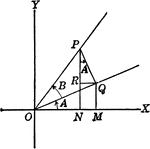
Angles Used to Illustrate Sum and Difference of Two Angles
Angles used to illustrate the sum and difference of two angles and trig identities.
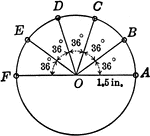
Circle With 36 degree Angles and Radius 1.5 in.
Circle with 36 degree angles marked. This diagram can be used with the following trig problem: Locate…
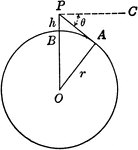
Circle With Center o and Radius r with point P
Circle modeling the earth. O is the center of the earth, r the radius of the earth, and h the height…
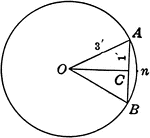
Circle With a Chord of 2 ft. and a Radius of 3 ft.
Circle with chord AB=2 ft. and radius OA = 3 ft.. Triangle AOC is a right triangle. Angle AOC=half angle…

Unit Circle
Illustration of a unit circle (circle with a radius of 1) superimposed on the coordinate plane. The…
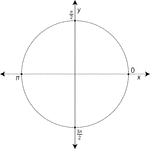
Unit Circle Labeled At Quadrantal Angles
Illustration of a unit circle (circle with a radius of 1) superimposed on the coordinate plane with…

Unit Circle Labeled At Special Angles
Illustration of a unit circle (circle with a radius of 1) superimposed on the coordinate plane with…
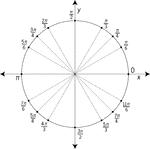
Unit Circle Labeled At Special Angles
Illustration of a unit circle (circle with a radius of 1) superimposed on the coordinate plane with…
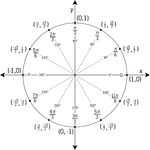
Unit Circle Labeled In 30° Increments With Values
Illustration of a unit circle (circle with a radius of 1) superimposed on the coordinate plane with…
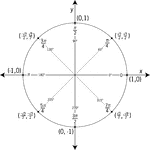
Unit Circle Labeled In 45 ° Increments
Illustration of a unit circle (circle with a radius of 1) superimposed on the coordinate plane with…
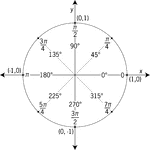
Unit Circle Labeled In 45° Increments With Values
Illustration of a unit circle (circle with a radius of 1) superimposed on the coordinate plane with…
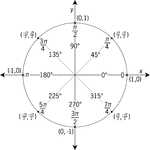
Unit Circle Labeled In 45° Increments With Values
Illustration of a unit circle (circle with a radius of 1) superimposed on the coordinate plane with…
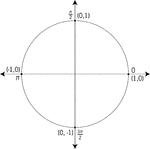
Unit Circle Labeled With Quadrantal Angles And Values
Illustration of a unit circle (circle with a radius of 1) superimposed on the coordinate plane. All…
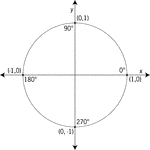
Unit Circle Labeled With Quadrantal Angles And Values
Illustration of a unit circle (circle with a radius of 1) superimposed on the coordinate plane with…

Unit Circle Labeled With Quadrantal Angles And Values
Illustration of a unit circle (circle with a radius of 1) superimposed on the coordinate plane with…
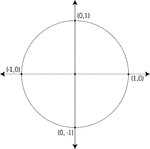
Unit Circle Labeled With Quadrantal Values
Illustration of a unit circle (circle with a radius of 1) superimposed on the coordinate plane. At each…
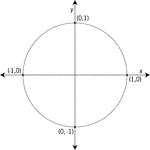
Unit Circle Labeled With Quadrantal Values
Illustration of a unit circle (circle with a radius of 1) superimposed on the coordinate plane with…
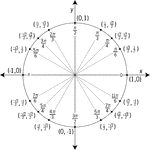
Unit Circle Labeled With Special Angles And Values
Illustration of a unit circle (circle with a radius of 1) superimposed on the coordinate plane with…
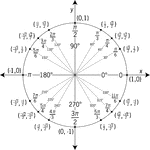
Unit Circle Labeled With Special Angles And Values
Illustration of a unit circle (circle with a radius of 1) superimposed on the coordinate plane with…
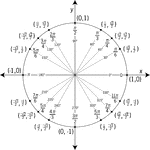
Unit Circle Labeled With Special Angles And Values
Illustration of a unit circle (circle with a radius of 1) superimposed on the coordinate plane with…
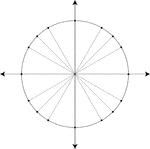
Unit Circle Marked At Special Angles
Illustration of a unit circle (circle with a radius of 1) superimposed on the coordinate plane. All…

Projection of Points in Circular Motion
Illustration of the projection of point P as it moves around a vertical circle of radius 3 in. in a…

Projection of Points in Circular Motion
Illustration of the projection of point P as it moves around a vertical circle of radius 2 ft. in a…

Coordinate Axis With Angles, Lines, and Perpendiculars Drawn
Coordinate axis with angle XOP equal to theta, Θ, and angle XOQ=180 - Θ. From any point in the terminal…
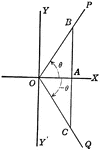
Coordinate Axis With Perpendiculars Drawn To Form Similar Right Triangles From Positive and Negative Theta, Θ
Angle XOP=Θ and angle XOQ=- Θ. From a point in the terminal side of each a perpendicular line is drawn…

Coordinate Axis With Perpendiculars Drawn To Form Similar Right Triangles
Angle XOP=Θ and angle XOQ=90+Θ. From a point in the terminal side of each a perpendicular line is…
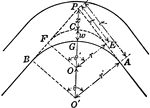
Curve in Pavement of Road
Illustration of blueprint used by highway engineers to widen the pavement on the inside of the curve…

Trigonometry Grid With Domain -π to π And Range -1 to 1
Illustration of a trigonometric grid with a domain from -π to π and a range from -1 to 1. The…

Trigonometry Grid With Domain -π to π And Range -1 to 1
Illustration of a trigonometric grid with a domain from -π to π and a range from -1 to 1. The…

Trigonometry Grid With Domain -π to π And Range -1 to 1
Illustration of a trigonometric grid with a domain from -π to π and a range from -1 to 1. The…

Trigonometry Grid With Domain -π to π And Range -10 to 10
Illustration of a trigonometric grid with a domain from -π to π and a range from -10 to 10. The…

Trigonometry Grid With Domain -π to π And Range -10 to 10
Illustration of a trigonometric grid with a domain from -π to π and a range from -10 to 10. The…

Trigonometry Grid With Domain -π to π And Range -10 to 10
Illustration of a trigonometric grid with a domain from -π to π and a range from -10 to 10. The…

Trigonometry Grid With Domain -π to π And Range -2 to 2
Illustration of a trigonometric grid with a domain from -π to π and a range from -2 to 2. The…

Trigonometry Grid With Domain -π to π And Range -2 to 2
Illustration of a trigonometric grid with a domain from -π to π and a range from -2 to 2. The…

Trigonometry Grid With Domain -π to π And Range -2 to 2
Illustration of a trigonometric grid with a domain from -π to π and a range from -2 to 2. The…

Trigonometry Grid With Domain -π to π And Range -3 to 3
Illustration of a trigonometric grid with a domain from -π to π and a range from -3 to 3. The…
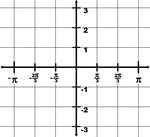
Trigonometry Grid With Domain -π to π And Range -3 to 3
Illustration of a trigonometric grid with a domain from -π to π and a range from -3 to 3. The…

Trigonometry Grid With Domain -π to π And Range -3 to 3
Illustration of a trigonometric grid with a domain from -π to π and a range from -3 to 3. The…
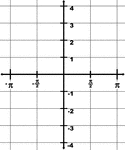
Trigonometry Grid With Domain -π to π And Range -4 to 4
Illustration of a trigonometric grid with a domain from -π to π and a range from -4 to 4. The…
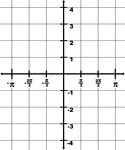
Trigonometry Grid With Domain -π to π And Range -4 to 4
Illustration of a trigonometric grid with a domain from -π to π and a range from -4 to 4. The…
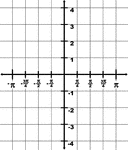
Trigonometry Grid With Domain -π to π And Range -4 to 4
Illustration of a trigonometric grid with a domain from -π to π and a range from -4 to 4. The…
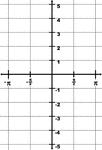
Trigonometry Grid With Domain -π to π And Range -5 to 5
Illustration of a trigonometric grid with a domain from -π to π and a range from -5 to 5. The…
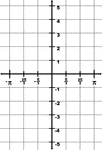
Trigonometry Grid With Domain -π to π And Range -5 to 5
Illustration of a trigonometric grid with a domain from -π to π and a range from -5 to 5. The…
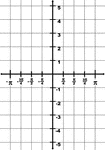
Trigonometry Grid With Domain -π to π And Range -5 to 5
Illustration of a trigonometric grid with a domain from -π to π and a range from -5 to 5. The…

Trigonometry Grid With Domain -π to π And Range -6 to 6
Illustration of a trigonometric grid with a domain from -π to π and a range from -6 to 6. The…

Trigonometry Grid With Domain -π to π And Range -6 to 6
Illustration of a trigonometric grid with a domain from -π to π and a range from -6 to 6. The…

Trigonometry Grid With Domain -π to π And Range -6 to 6
Illustration of a trigonometric grid with a domain from -π to π and a range from -6 to 6. The…

Trigonometry Grid With Domain -π to π And Range -7 to 7
Illustration of a trigonometric grid with a domain from -π to π and a range from -7 to 7. The…

Trigonometry Grid With Domain -π to π And Range -7 to 7
Illustration of a trigonometric grid with a domain from -π to π and a range from -7 to 7. The…

Trigonometry Grid With Domain -π to π And Range -7 to 7
Illustration of a trigonometric grid with a domain from -π to π and a range from -7 to 7. The…

Trigonometry Grid With Domain -π to π And Range -8 to 8
Illustration of a trigonometric grid with a domain from -π to π and a range from -8 to 8. The…

Trigonometry Grid With Domain -π to π And Range -8 to 8
Illustration of a trigonometric grid with a domain from -π to π and a range from -8 to 8. The…

Trigonometry Grid With Domain -π to π And Range -8 to 8
Illustration of a trigonometric grid with a domain from -π to π and a range from -8 to 8. The…

Trigonometry Grid With Domain -π to π And Range -9 to 9
Illustration of a trigonometric grid with a domain from -π to π and a range from -9 to 9. The…

Trigonometry Grid With Domain -π to π And Range -9 to 9
Illustration of a trigonometric grid with a domain from -π to π and a range from -9 to 9. The…

Trigonometry Grid With Domain -π to π And Range -9 to 9
Illustration of a trigonometric grid with a domain from -π to π and a range from -9 to 9. The…
Trigonometry Grid With Domain -2π to 2π And Range -1 to 1
Illustration of a trigonometric grid with a domain from -2π to 2π and a range from -1 to 1. The…
Trigonometry Grid With Domain -2π to 2π And Range -1 to 1
Illustration of a trigonometric grid with a domain from -2π to 2π and a range from -1 to 1. The…
